Selected videos - show reel
Pola Sieverding
Pola Sieverding
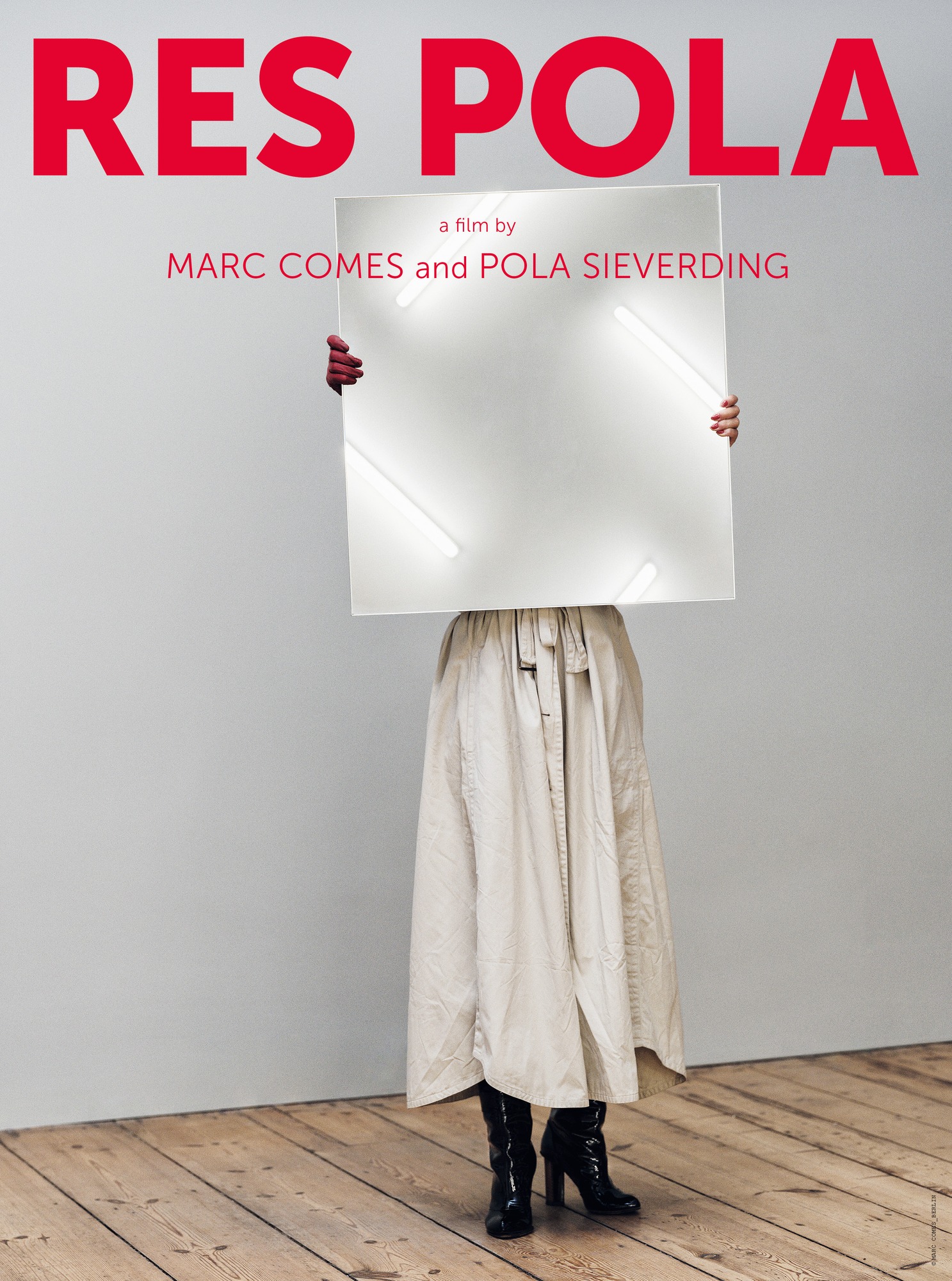
RES POLA
A film by Marc Comes and Pola Sieverding.
2021/23
18 Minutes.
RES POLA
A film by Marc Comes and Pola Sieverding.
2021/23
18 Minutes.
RES POLA is a film starring the artist Pola Sieverding and her work. Here the distinctions between real and fictional, in front of and behind the camera, inside and outside, touch and image, seduction and exchange become fluid.
The collaboration of filmmaker Marc Comes and the artist and protagonist is rather an encounter that becomes an image, an audiovisual palpation of how sensual perception guides to concept and finally to work, than a classical portrait.
An adventurous red glove, an independent sound level, a chorus of Greek statues, kissing collaborators, and the hermaphroditic complementary currency „Oysters“ are core motifs.
A film by Marc Comes and Pola Sieverding.
2021/23
18 Minutes.
RES POLA
A film by Marc Comes and Pola Sieverding.
2021/23
18 Minutes.
RES POLA is a film starring the artist Pola Sieverding and her work. Here the distinctions between real and fictional, in front of and behind the camera, inside and outside, touch and image, seduction and exchange become fluid.
The collaboration of filmmaker Marc Comes and the artist and protagonist is rather an encounter that becomes an image, an audiovisual palpation of how sensual perception guides to concept and finally to work, than a classical portrait.
An adventurous red glove, an independent sound level, a chorus of Greek statues, kissing collaborators, and the hermaphroditic complementary currency „Oysters“ are core motifs.
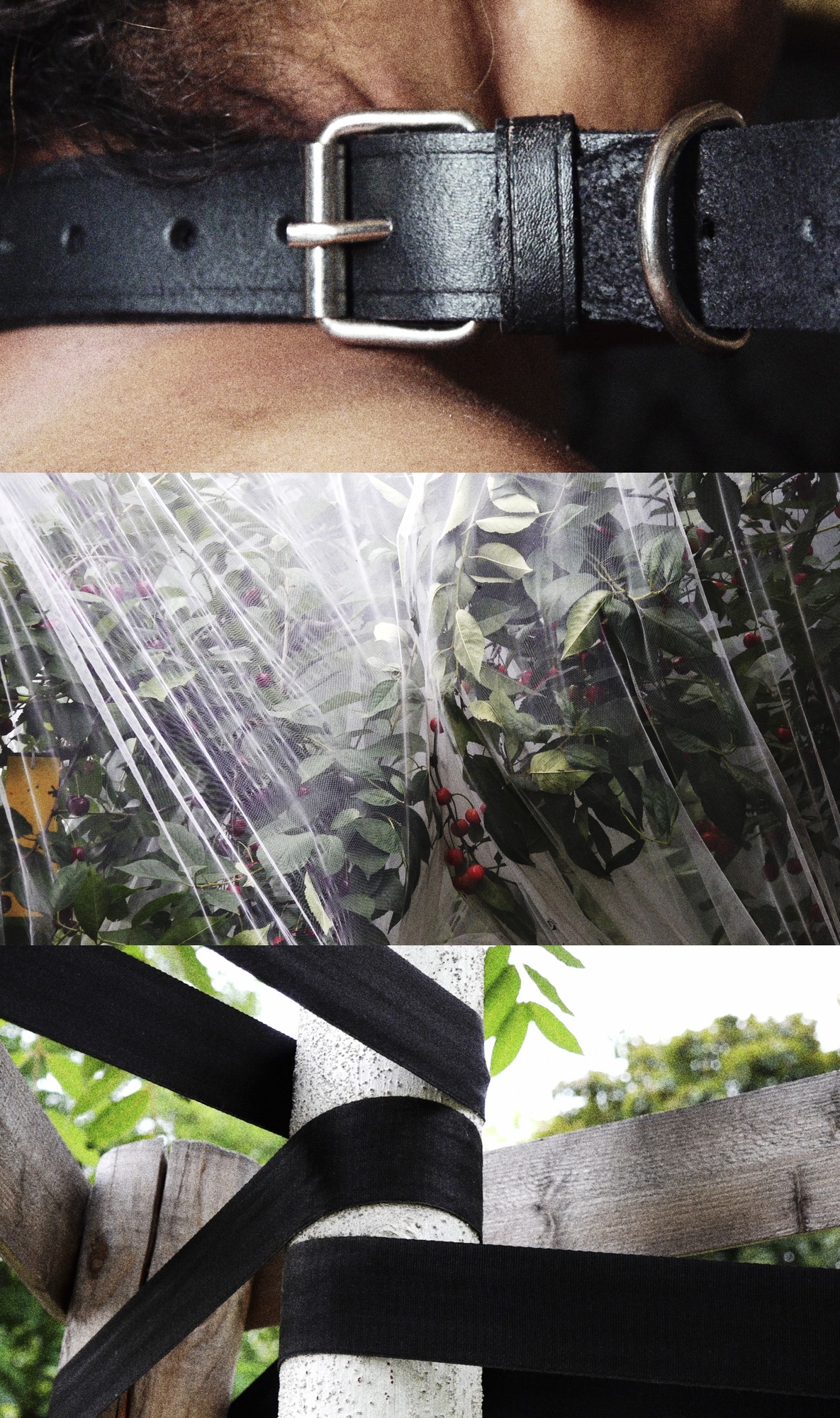
ich hatte die deutliche Empfindung, daß mein Zwerchfell ganz oben in der Brust fast unmittelbar unter dem Kehlkopfe saß
2021
HD Video, Sound
In der Videoinstallation "ich hatte die deutliche Empfindung, daß mein Zwerchfell ganz oben in der Brust fast unmittelbar unter dem Kehlkopfe saß" sehen wir Baumstämme, die mithilfe von Gurten und Seilen standfest und gerade gehalten werden, Zeichnungen von Ledergurten zur Korrektur der Sitz- und Kieferhaltung bei Kindern, Details von Körpern in Bondageschlingen, Netze und Metallgestänge zum Schutz und zum optimalen Wuchs von Pflanzen. Die Textfetzen sind u.a. dem Buch „Denkwürdigkeiten eines Nervenkranken“ von Daniel Paul Schreber entlehnt, in denen er seine Körperempfindungen und Wahrnehmungen zu den (zeitweiligen) Veränderungen seines Körpers während seines mehrjährigen Aufenthalts in der psychiatrischen Anstalt beschreibt. Weitere Soundelemente kommen direkt aus der Schreber- bzw. Kleingartenanlage, in der die Arbeit gezeigt wird. Namensgeber der sog. Schreber- bzw. Kleingarten-Bewegung und Autor der Zeichnungen, die wir sehen, von orthopädischen Apparaten, dem Geradehalter oder dem Kinnband, ist Daniel Gottlob Moritz Schreber, Es handelt sich um audiovisuelle Fragmente und Überlegungen, die weniger in kausaler Reihenfolge als vielmehr als narrative Fläche versuchen, verschiedene Punkte zu verbinden: das Bedürfnis sich aufzurichten und abzugrenzen, Terrain zu parzellieren, um Freiräume zu definieren, Körper wie Pflanzen zu kultivieren und konditionieren und diese Konditionierung durch Lustgewinn zu unterwandern.
2021
HD Video, Sound
In der Videoinstallation "ich hatte die deutliche Empfindung, daß mein Zwerchfell ganz oben in der Brust fast unmittelbar unter dem Kehlkopfe saß" sehen wir Baumstämme, die mithilfe von Gurten und Seilen standfest und gerade gehalten werden, Zeichnungen von Ledergurten zur Korrektur der Sitz- und Kieferhaltung bei Kindern, Details von Körpern in Bondageschlingen, Netze und Metallgestänge zum Schutz und zum optimalen Wuchs von Pflanzen. Die Textfetzen sind u.a. dem Buch „Denkwürdigkeiten eines Nervenkranken“ von Daniel Paul Schreber entlehnt, in denen er seine Körperempfindungen und Wahrnehmungen zu den (zeitweiligen) Veränderungen seines Körpers während seines mehrjährigen Aufenthalts in der psychiatrischen Anstalt beschreibt. Weitere Soundelemente kommen direkt aus der Schreber- bzw. Kleingartenanlage, in der die Arbeit gezeigt wird. Namensgeber der sog. Schreber- bzw. Kleingarten-Bewegung und Autor der Zeichnungen, die wir sehen, von orthopädischen Apparaten, dem Geradehalter oder dem Kinnband, ist Daniel Gottlob Moritz Schreber, Es handelt sich um audiovisuelle Fragmente und Überlegungen, die weniger in kausaler Reihenfolge als vielmehr als narrative Fläche versuchen, verschiedene Punkte zu verbinden: das Bedürfnis sich aufzurichten und abzugrenzen, Terrain zu parzellieren, um Freiräume zu definieren, Körper wie Pflanzen zu kultivieren und konditionieren und diese Konditionierung durch Lustgewinn zu unterwandern.
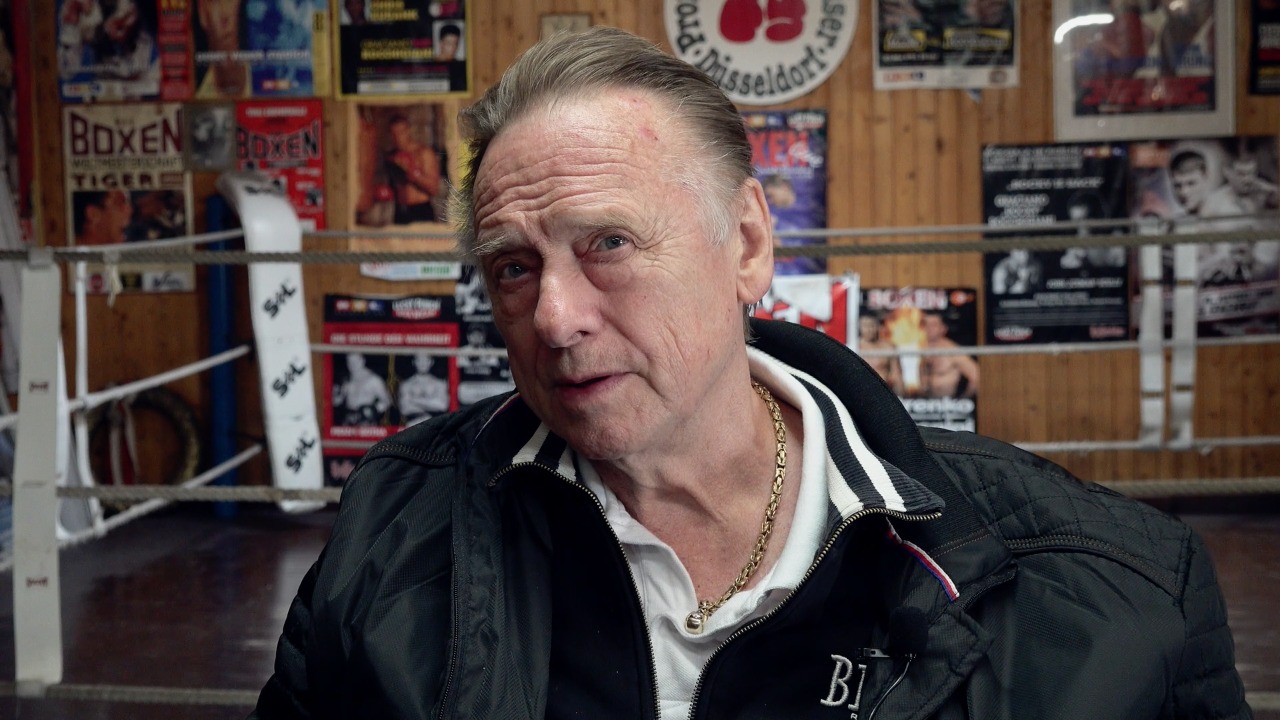
VULKANSTRASSE
2018/19, 55 Minuten.
Ein Film von Pola Sieverding
In VULKANSTRASSE begleitet die Kamera Wilfried Weiser durch Fotoalben und Erzählungen seines Lebens, das eng verwoben ist mit dem deutschen Boxsport der 80er und 90er Jahre. Die Gegend um die Vulkanstraße ist der letzte Teil des ehemaligen Düsseldorfer Rotlichtviertels. In direkter Nachbarschaft zum nordafrikanisch geprägten Viertel um die Ellerstraße ist heute überall Sperrbezirk, außer am Bahndamm. Hier wurde ein Haus geschaffen, das jeder vom Zug aus sieht und kennt. Hunderte Prostituierte bieten im Hinterhofmilieu ihre Dienste an. Gleich daneben findet man die letzten Zeichen einer Legende: die Kneipe "Beim Box-Papst" wird von außen geziert durch die Konterfeis großer Boxer. Vorne eine Kneipe mit unzähligen Fotos vergangener Siege und Protagonisten an den holzvertäfelten Wänden, die geradezu ein Prototyp der deutschen Eckkneipe ist und dahinter die Boxhalle, einst Trainingsring für Box-Weltmeister wie Graciano Rocchicciani, Henry Maske oder Daisy Lang.
Es ist eine Geschichte, die von der Entwicklung eines Viertels handelt und die Lebenstationen der dort ansässigen Menschen nachzeichnet. Es geht um Körper, die in den Ring steigen oder sich auf der Strasse anbieten, die Erleichterung im Alkohol suchen und sich sehnen nach einem Früher und selber mit dem Alter konfrontiert sind. Es sind Figuren, die nach dem Glück suchen, es finden und wieder verlieren, deren Bühne die Strasse, vorallem aber die beleuchtete Arena ist. Es ist auch ein Stück Bundesrepublikanische Geschichte, die im Millieu erzählt wird und den Stadtteil Oberbilk in Düsseldorf, geprägt durch die Stahlindustrie des frühen 20. Jahrhunderts, Prostitution und Migration, dennoch nicht verlassen muss.
2018/19, 55 Minuten.
Ein Film von Pola Sieverding
In VULKANSTRASSE begleitet die Kamera Wilfried Weiser durch Fotoalben und Erzählungen seines Lebens, das eng verwoben ist mit dem deutschen Boxsport der 80er und 90er Jahre. Die Gegend um die Vulkanstraße ist der letzte Teil des ehemaligen Düsseldorfer Rotlichtviertels. In direkter Nachbarschaft zum nordafrikanisch geprägten Viertel um die Ellerstraße ist heute überall Sperrbezirk, außer am Bahndamm. Hier wurde ein Haus geschaffen, das jeder vom Zug aus sieht und kennt. Hunderte Prostituierte bieten im Hinterhofmilieu ihre Dienste an. Gleich daneben findet man die letzten Zeichen einer Legende: die Kneipe "Beim Box-Papst" wird von außen geziert durch die Konterfeis großer Boxer. Vorne eine Kneipe mit unzähligen Fotos vergangener Siege und Protagonisten an den holzvertäfelten Wänden, die geradezu ein Prototyp der deutschen Eckkneipe ist und dahinter die Boxhalle, einst Trainingsring für Box-Weltmeister wie Graciano Rocchicciani, Henry Maske oder Daisy Lang.
Es ist eine Geschichte, die von der Entwicklung eines Viertels handelt und die Lebenstationen der dort ansässigen Menschen nachzeichnet. Es geht um Körper, die in den Ring steigen oder sich auf der Strasse anbieten, die Erleichterung im Alkohol suchen und sich sehnen nach einem Früher und selber mit dem Alter konfrontiert sind. Es sind Figuren, die nach dem Glück suchen, es finden und wieder verlieren, deren Bühne die Strasse, vorallem aber die beleuchtete Arena ist. Es ist auch ein Stück Bundesrepublikanische Geschichte, die im Millieu erzählt wird und den Stadtteil Oberbilk in Düsseldorf, geprägt durch die Stahlindustrie des frühen 20. Jahrhunderts, Prostitution und Migration, dennoch nicht verlassen muss.
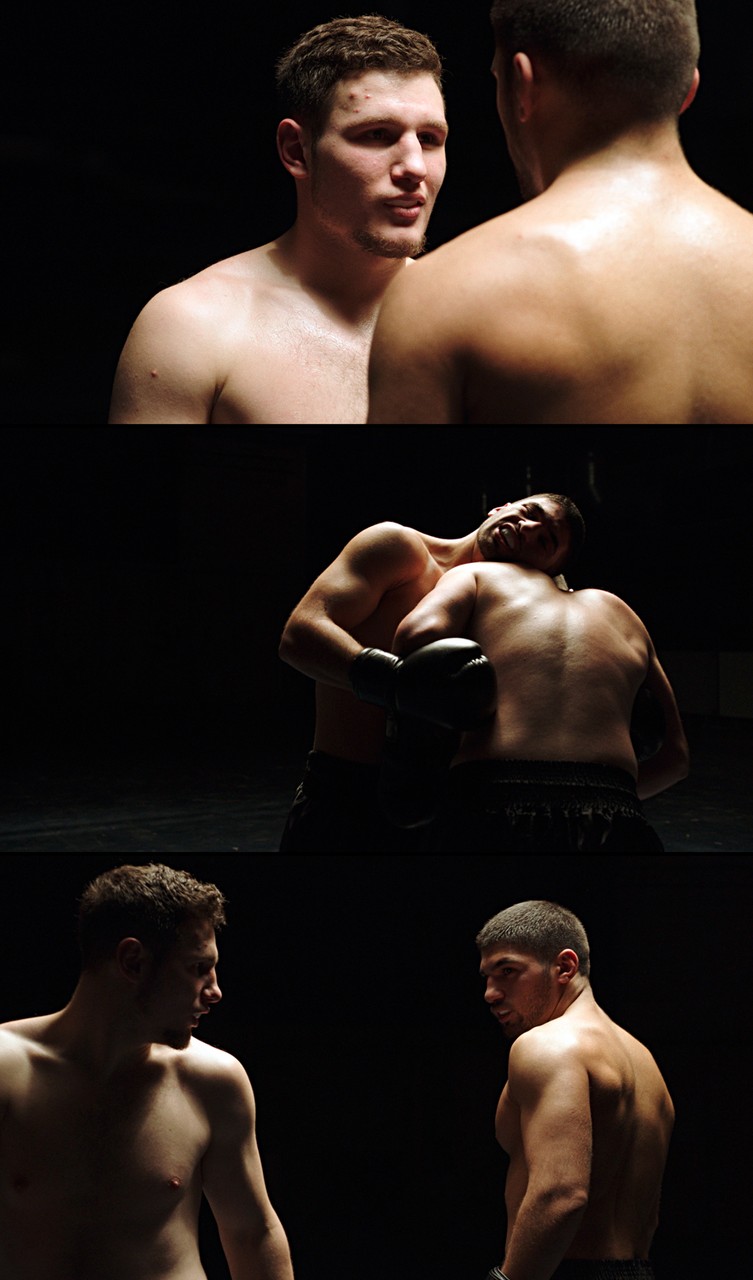
The Epic
2016
HD Video, Sound, 24’14’’
Starring: Abdullah Karalioglu, Azamat Machmudov
Director: Pola Sieverding
Director of Photography: Christoph Manz
Editor: Pola Sieverding
Colorist: Christoph Manz
Music: Orson Sieverding
Sound: Julian Holzapfel, Orson Sieverding
Dolly Operator: Stephan Thierbach
Production Assistants: Joelle Grosz, Thomas Koester, Leopold Wollenberger
Funded by: Kunststiftung NRW
In The Epic, the camera circles around two boxers like a group of sculptures, thus defining the space in which their bodies collide into one another. At the start of the video, the boxers each look in the direction of the camera with a frontal body posture, drawing attention to the solitude of the ring. In the shots that follow, the camera moves and gradually rotates 360 degrees around the boxers in motion, as they first size each other up with their eyes, then dance around their foe and partner, and at last begin fighting with fists. The camera follows the fight slowed down by a factor of eight, filming at 200 frames per second. The result is to make it possible to understand the forces acting on the bodies, shaping them and laying bare their anatomy. The interplay of the two bodies is like that of a dance, and calling to mind archaic sculptures, their flesh tone glistening with sweat. The film’s third act concentrates on the moment in which the fighters are in each other’s arms, in what is called a clinch. This clasping is a moment of ambiguity: a flickering between exhaustion and feint, getting closer and giving up. It is also a moment of immense sensuality. The opulence of the images is critically supported by the film’s soundtrack. This is made up of the sounds of the blows, footfalls, breathing and heart frequencies as recorded during the actual fight, generating an acoustic space using sound waves to convey the physicality of the fight onto the viewers’ bodies.
2016
HD Video, Sound, 24’14’’
Starring: Abdullah Karalioglu, Azamat Machmudov
Director: Pola Sieverding
Director of Photography: Christoph Manz
Editor: Pola Sieverding
Colorist: Christoph Manz
Music: Orson Sieverding
Sound: Julian Holzapfel, Orson Sieverding
Dolly Operator: Stephan Thierbach
Production Assistants: Joelle Grosz, Thomas Koester, Leopold Wollenberger
Funded by: Kunststiftung NRW
In The Epic, the camera circles around two boxers like a group of sculptures, thus defining the space in which their bodies collide into one another. At the start of the video, the boxers each look in the direction of the camera with a frontal body posture, drawing attention to the solitude of the ring. In the shots that follow, the camera moves and gradually rotates 360 degrees around the boxers in motion, as they first size each other up with their eyes, then dance around their foe and partner, and at last begin fighting with fists. The camera follows the fight slowed down by a factor of eight, filming at 200 frames per second. The result is to make it possible to understand the forces acting on the bodies, shaping them and laying bare their anatomy. The interplay of the two bodies is like that of a dance, and calling to mind archaic sculptures, their flesh tone glistening with sweat. The film’s third act concentrates on the moment in which the fighters are in each other’s arms, in what is called a clinch. This clasping is a moment of ambiguity: a flickering between exhaustion and feint, getting closer and giving up. It is also a moment of immense sensuality. The opulence of the images is critically supported by the film’s soundtrack. This is made up of the sounds of the blows, footfalls, breathing and heart frequencies as recorded during the actual fight, generating an acoustic space using sound waves to convey the physicality of the fight onto the viewers’ bodies.
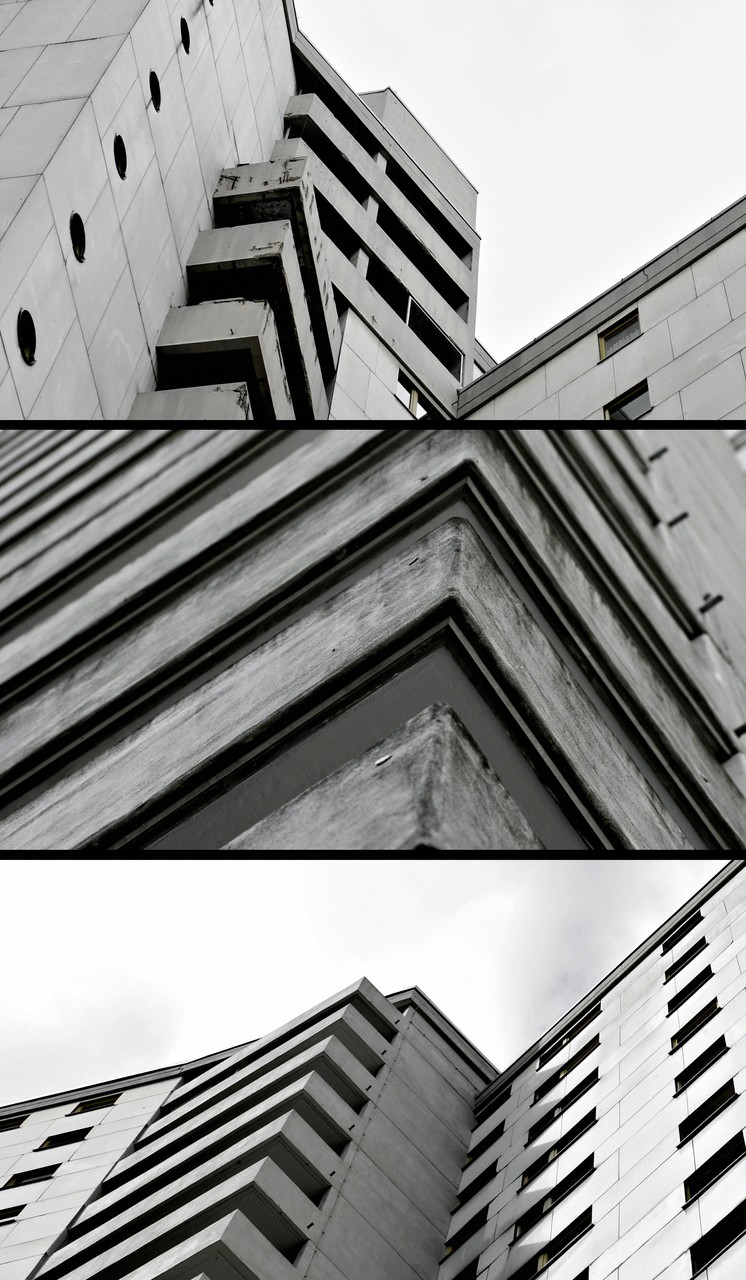
Close To Concrete II
2014
HD Video, Sound, 15’20’’
Filmed in Berlin.
Camera: Pola Sieverding, Ulrich Urban
Editing: Pola Sieverding
Digital Mastering: Christoph Manz
Sound Design: Julian Holzapfel, Orson Sieverding
Sound Sources: “Symphonies of the planets – NASA Voyager Recordings”, 1977; “Ballade von der Unzulänglichkeit menschlichen Strebens”, Bertold Brecht, 1928; “Alphaville, une étrange aventure de Lemmy Caution”, Jean-Luc Godard, 1965
„Ein Geheimnis, das sich niemals ändert, weder bei Tag noch bei Nacht, es handelt sich um eine Vergangenheit, die zugleich die Zukunft verkörpert, die auf einer geraden Linie weiterverläuft und doch am Ende einen Kreis beschließt.“
Lemmy Caution zu Alpha 60
„Something that never changes, by day, or by night. The past represents its future. It goes forth in a straight line, yet it ends by coming full circle.“
Lemmy Caution to Alpha 60
Following the video CLOSE TO CONCRETE I, that was filmed in Lisbon in 2011, CLOSE TO CONCRETE II, filmed in Berlin in 2014, is the second in a series of architectural portraits by Pola Sieverding.
Both videos not only show how much formal aesthetic concepts of art since the early 20th century have conditioned our gaze towards our surrounding but also her interest in materiality seen through the camera and the narrative quality of (atmospheric) sound.
In CLOSE TO CONCRETE II we see the façades of Märkisches Viertel and Marzahn-Hellersdorf, two large-scale housing estates in Berlin. The camera slowly and deliberately pans across its main materiality, concrete, and the structures formed by its windows invite the viewer to contemplate not only the architecture’s aesthetic language but also about the living space it is defining.
Developed from different sources like the “Symphonies of the planets - NASA Voyager Recordings” from 1977 or Jean-Luc Godard’s “Alphaville” from 1965 and a certain “space” sound composed from various wind recordings and syntheziser sounds, the soundtrack enhances the idea of a distant future which has now become the present. That present being the mid-20th century with its race to the moon and modern concepts of mass organization.
2014
HD Video, Sound, 15’20’’
Filmed in Berlin.
Camera: Pola Sieverding, Ulrich Urban
Editing: Pola Sieverding
Digital Mastering: Christoph Manz
Sound Design: Julian Holzapfel, Orson Sieverding
Sound Sources: “Symphonies of the planets – NASA Voyager Recordings”, 1977; “Ballade von der Unzulänglichkeit menschlichen Strebens”, Bertold Brecht, 1928; “Alphaville, une étrange aventure de Lemmy Caution”, Jean-Luc Godard, 1965
„Ein Geheimnis, das sich niemals ändert, weder bei Tag noch bei Nacht, es handelt sich um eine Vergangenheit, die zugleich die Zukunft verkörpert, die auf einer geraden Linie weiterverläuft und doch am Ende einen Kreis beschließt.“
Lemmy Caution zu Alpha 60
„Something that never changes, by day, or by night. The past represents its future. It goes forth in a straight line, yet it ends by coming full circle.“
Lemmy Caution to Alpha 60
Following the video CLOSE TO CONCRETE I, that was filmed in Lisbon in 2011, CLOSE TO CONCRETE II, filmed in Berlin in 2014, is the second in a series of architectural portraits by Pola Sieverding.
Both videos not only show how much formal aesthetic concepts of art since the early 20th century have conditioned our gaze towards our surrounding but also her interest in materiality seen through the camera and the narrative quality of (atmospheric) sound.
In CLOSE TO CONCRETE II we see the façades of Märkisches Viertel and Marzahn-Hellersdorf, two large-scale housing estates in Berlin. The camera slowly and deliberately pans across its main materiality, concrete, and the structures formed by its windows invite the viewer to contemplate not only the architecture’s aesthetic language but also about the living space it is defining.
Developed from different sources like the “Symphonies of the planets - NASA Voyager Recordings” from 1977 or Jean-Luc Godard’s “Alphaville” from 1965 and a certain “space” sound composed from various wind recordings and syntheziser sounds, the soundtrack enhances the idea of a distant future which has now become the present. That present being the mid-20th century with its race to the moon and modern concepts of mass organization.
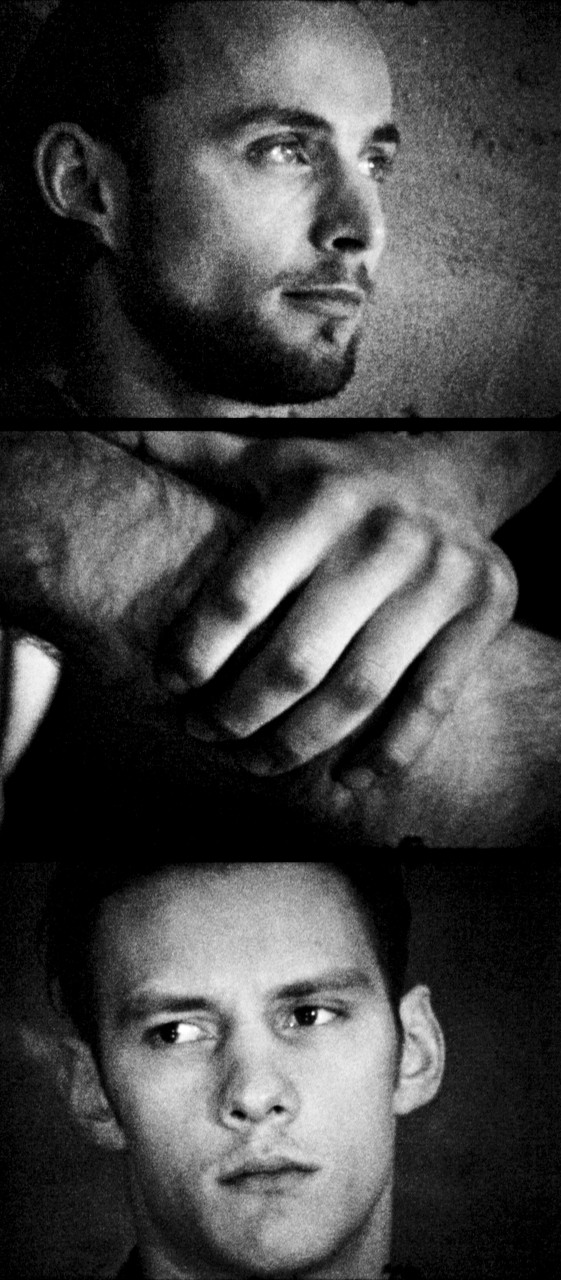
Untitled
2013
8 mm Film transferred to HD, Sound, 3’42’’
Starring Ulrich Urban and Markus Hollenbach.
Music by Orson Sieverding.
Skin or texture, row or romance, fight club or pleasure dome.
On aspects of gender performance and the theatricality of the fight.
2013
8 mm Film transferred to HD, Sound, 3’42’’
Starring Ulrich Urban and Markus Hollenbach.
Music by Orson Sieverding.
Skin or texture, row or romance, fight club or pleasure dome.
On aspects of gender performance and the theatricality of the fight.
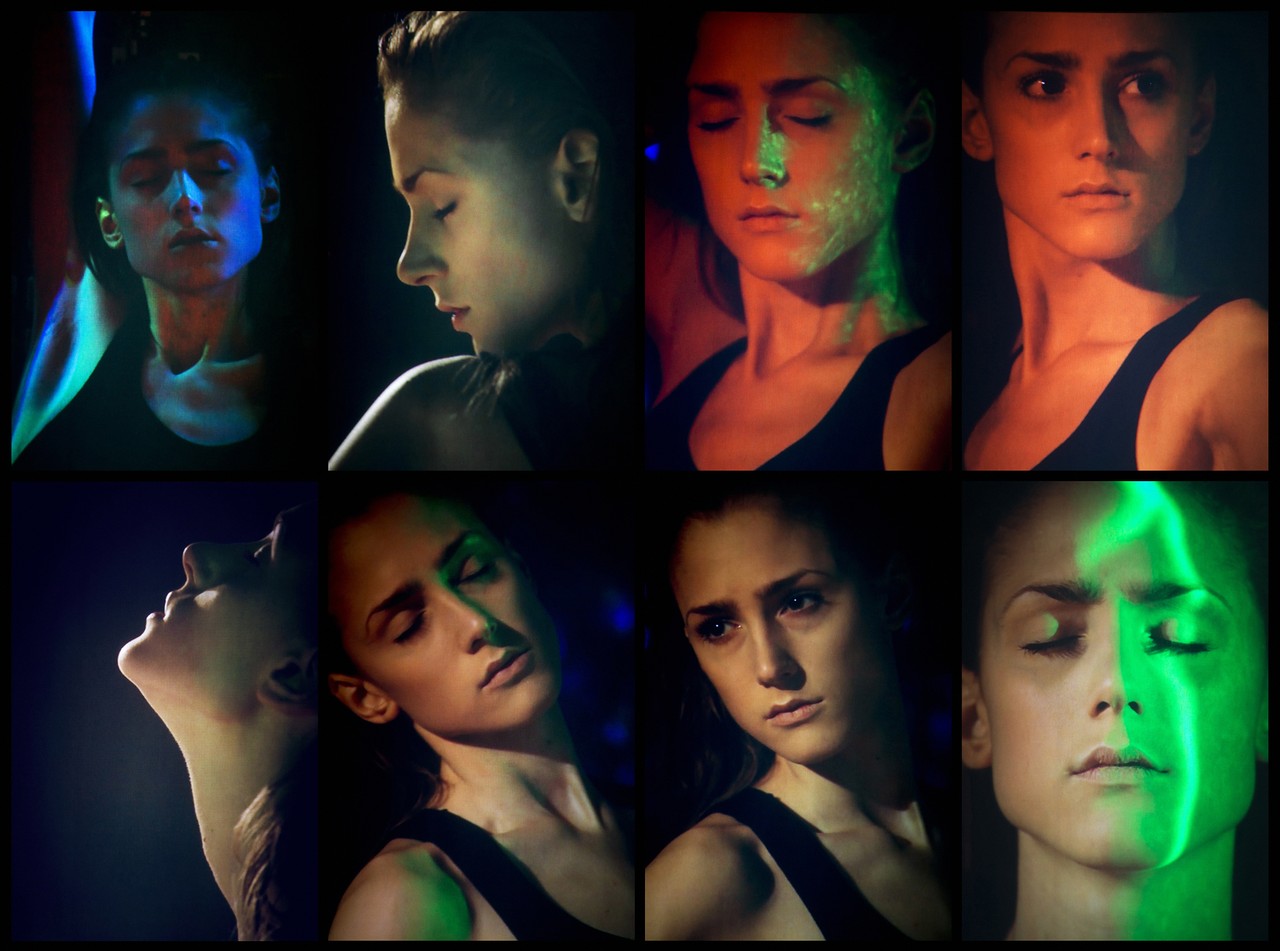
Cross Metropolis Machine
2012
HD Video, Sound, 14’02’’
The video installation Cross Metropolis Machine maps the movements of a perfomer responding to industrial electronic music and contemplates on the body as recording and relating to the diverse forces that act upon it.
In response to Close To Concrete (2011) also Cross Metropolis Machine (2012) reflects on the interaction and on the mutual conditioning of space (as in architecture as well as in urban concepts) and body.
For Cross Metropolis Machine Pola developed in collaboration with Orson Sieverding a track where the sounds of the city are echoing in the waves that sculpt the performers movements and relate it to early electronic music and its appropriation of the sound of the assembly line.
2012
HD Video, Sound, 14’02’’
The video installation Cross Metropolis Machine maps the movements of a perfomer responding to industrial electronic music and contemplates on the body as recording and relating to the diverse forces that act upon it.
In response to Close To Concrete (2011) also Cross Metropolis Machine (2012) reflects on the interaction and on the mutual conditioning of space (as in architecture as well as in urban concepts) and body.
For Cross Metropolis Machine Pola developed in collaboration with Orson Sieverding a track where the sounds of the city are echoing in the waves that sculpt the performers movements and relate it to early electronic music and its appropriation of the sound of the assembly line.
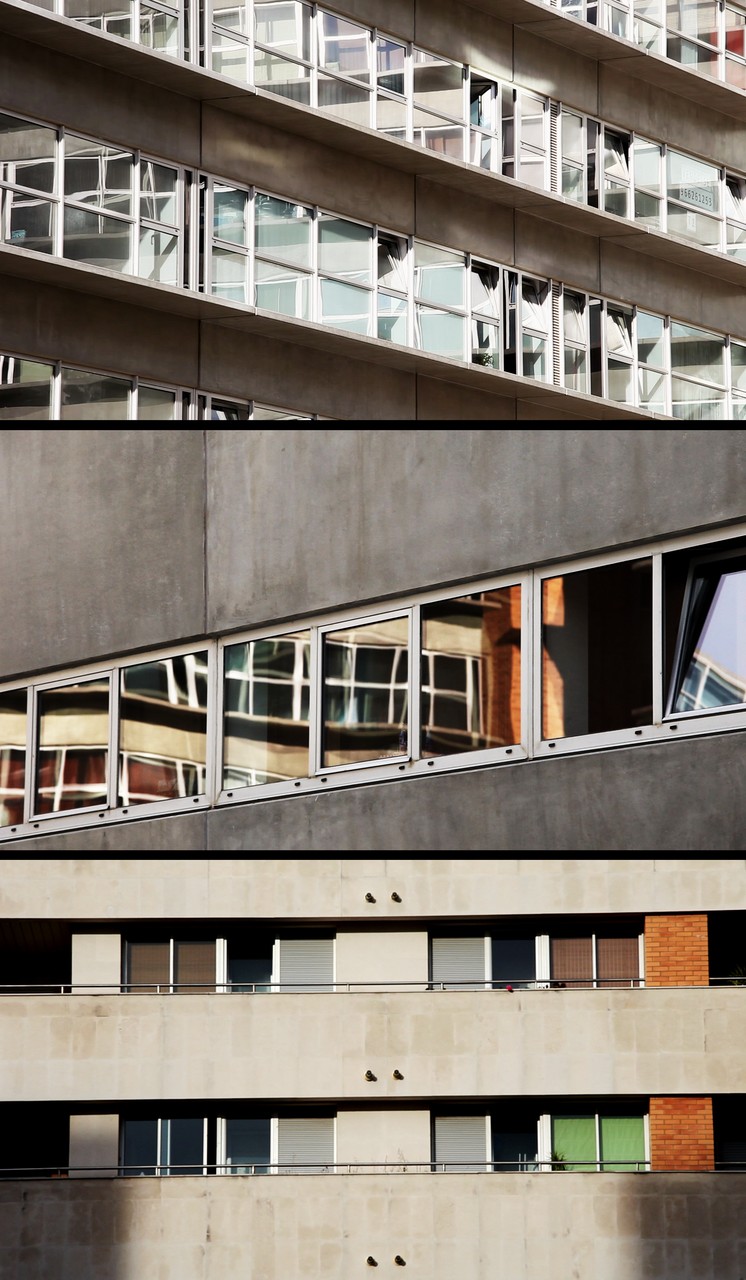
Close To Concrete I
2011
HD Video, Sound, 15’20’’
In this video the protagonists are the facades of one of the largest urban renewal projects in Europe and their visual reference to the concepts and aesthetics of the International Style of modernism. Although fascinated by the building’s qualities as minimalist scupltures the scanning close up of their surfaces might provoke a critical reflection on their inside.
We look at concrete representatives of an utopia, a no-space, that has absolutely no site specificity but defines very particular social spaces world-wide.
By treating architecture as a character in its own right, a method elaborated by Michelangelo Antonioni, Sieverding refers to the potential human space it determines.
The sound level, a variation of the opening sequence from “Once Upon A Time In The West” (C’era una volta il West) by Sergio Leone, links the images to ideas of conquest and how modernity has always also been a territorial project.
Similar to the function of a Stellvertreter (substitute) the visual level of the architectural space as well as the sound space create a mental space that speeks about those who are absent, those you might sense throughout the film as if they’ve just left the scenery, the people.
2011
HD Video, Sound, 15’20’’
In this video the protagonists are the facades of one of the largest urban renewal projects in Europe and their visual reference to the concepts and aesthetics of the International Style of modernism. Although fascinated by the building’s qualities as minimalist scupltures the scanning close up of their surfaces might provoke a critical reflection on their inside.
We look at concrete representatives of an utopia, a no-space, that has absolutely no site specificity but defines very particular social spaces world-wide.
By treating architecture as a character in its own right, a method elaborated by Michelangelo Antonioni, Sieverding refers to the potential human space it determines.
The sound level, a variation of the opening sequence from “Once Upon A Time In The West” (C’era una volta il West) by Sergio Leone, links the images to ideas of conquest and how modernity has always also been a territorial project.
Similar to the function of a Stellvertreter (substitute) the visual level of the architectural space as well as the sound space create a mental space that speeks about those who are absent, those you might sense throughout the film as if they’ve just left the scenery, the people.
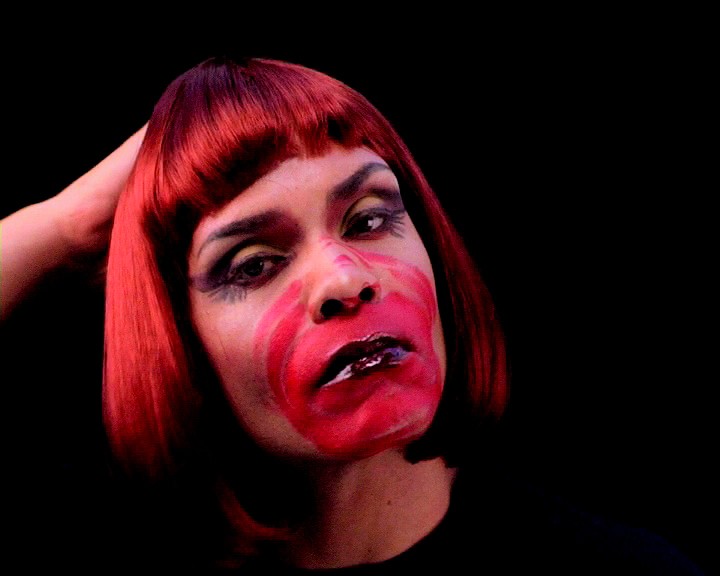
Make Up
2010
Video transferred to DVD, 31’28’’
In Make Up sehen wir LINK, wie er sich in Echtzeit schminkt, sein Gesicht zur Projektionsfläche werden lässt auf der er Bilder konstruiert, um sie im selben Moment wieder zu dekonstruieren und deren Schönheit abrupt durch einen Akt der Grenzüberschreitung in Frage gestellt wird, bevor er scheinbar wieder die Kontrolle über sein Spiegelbild gewinnt. In diesem Akt des Modellierens einer Oberfläche werden Fragen kultureller Zugehörigkeit und der Erarbeitung der Bildwerdung thematisiert. Schillernd ist die Grenze zwischen direkter Ansprache und Voyeurismus durch die Intimität und den Sog, der durch das vis-à-vis von direktem Blick, Kamera und “betrachtetem Betrachter” provoziert wird.
2010
Video transferred to DVD, 31’28’’
In Make Up sehen wir LINK, wie er sich in Echtzeit schminkt, sein Gesicht zur Projektionsfläche werden lässt auf der er Bilder konstruiert, um sie im selben Moment wieder zu dekonstruieren und deren Schönheit abrupt durch einen Akt der Grenzüberschreitung in Frage gestellt wird, bevor er scheinbar wieder die Kontrolle über sein Spiegelbild gewinnt. In diesem Akt des Modellierens einer Oberfläche werden Fragen kultureller Zugehörigkeit und der Erarbeitung der Bildwerdung thematisiert. Schillernd ist die Grenze zwischen direkter Ansprache und Voyeurismus durch die Intimität und den Sog, der durch das vis-à-vis von direktem Blick, Kamera und “betrachtetem Betrachter” provoziert wird.
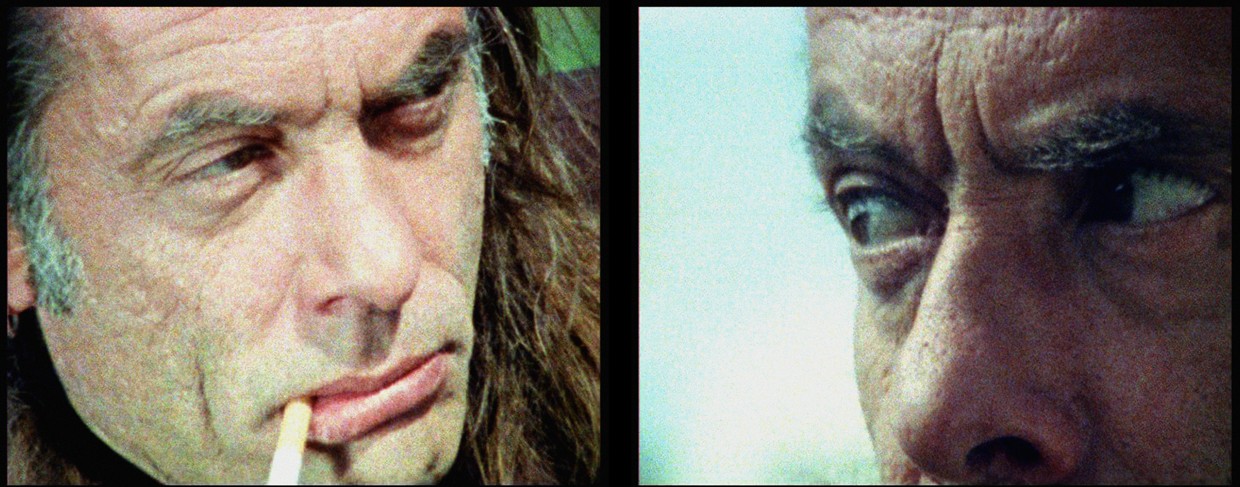
Face To Face
2010
8 mm Film transferred to DVD
2 channel video installation, size variable, 10’34’’, Loop
Filmed in Berlin.
Face to Face ist eine 2-Kanal Arbeit, gedreht auf Super 8 Film und transferiert auf Video, die Mex Schlüpfer im Dialog und direktem Blickwechsel, inszeniert als Schuss-/Gegenschuss-Situation, mit seiner eigenen Person zeigt. Momente großer Western zitierend, sehen wir ein Portrait, das die Eindeutigkeit seiner Funktion, seines Genres bereits während der Produktion hinterfragt und Männlichkeit als dramaturgische Figur konstruiert. Die Komplexität existentieller Fragen, Entscheidungen und das sich an der Grenze von einem Moment zu einem anderen Befindens, wird hier wie dort über den Blick veräußert.
2010
8 mm Film transferred to DVD
2 channel video installation, size variable, 10’34’’, Loop
Filmed in Berlin.
Face to Face ist eine 2-Kanal Arbeit, gedreht auf Super 8 Film und transferiert auf Video, die Mex Schlüpfer im Dialog und direktem Blickwechsel, inszeniert als Schuss-/Gegenschuss-Situation, mit seiner eigenen Person zeigt. Momente großer Western zitierend, sehen wir ein Portrait, das die Eindeutigkeit seiner Funktion, seines Genres bereits während der Produktion hinterfragt und Männlichkeit als dramaturgische Figur konstruiert. Die Komplexität existentieller Fragen, Entscheidungen und das sich an der Grenze von einem Moment zu einem anderen Befindens, wird hier wie dort über den Blick veräußert.
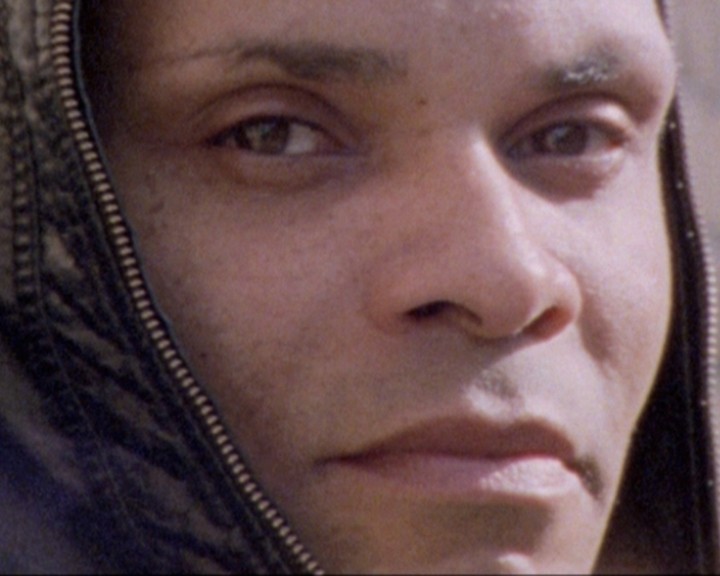
work in progress #2
2010
8mm Film transferred to DVD, 2’55’’, Loop
work in progress is a continuous portrait of one of the main characters Pola Sieverding is working with over the last years. A not to be finished screen test exploring the face as a screen itself.
2010
8mm Film transferred to DVD, 2’55’’, Loop
work in progress is a continuous portrait of one of the main characters Pola Sieverding is working with over the last years. A not to be finished screen test exploring the face as a screen itself.
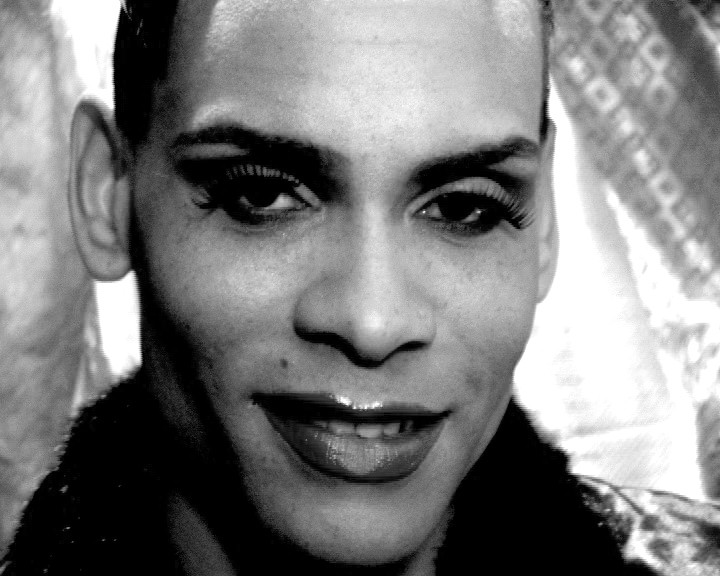
work in progress #1
2009
Video and 8mm Film transferred to DVD, 5’56’’, Loop
work in progress is a continuous portrait of one of the main characters Pola Sieverding is working with over the last years. A not to be finished screen test exploring the face as a screen itself.
2009
Video and 8mm Film transferred to DVD, 5’56’’, Loop
work in progress is a continuous portrait of one of the main characters Pola Sieverding is working with over the last years. A not to be finished screen test exploring the face as a screen itself.
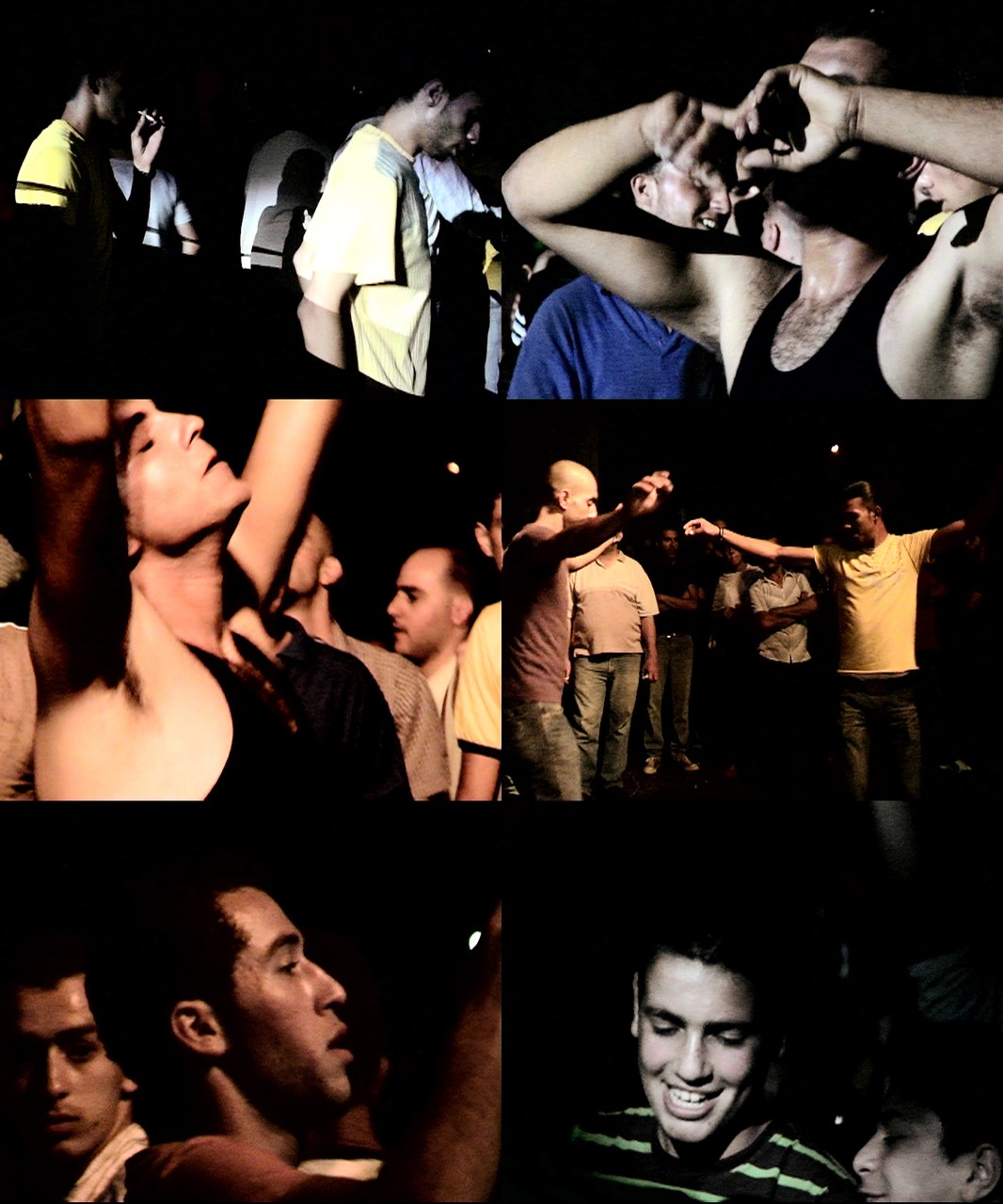
NOCTURNE ARABESQUE
2009
Video transferred to DVD, Sound, 3’45’’, Loop
Filmed in Ramallah, Palestine.
A portrait of the multiple images of manhood. Hide and seek in a night-time labyrinth of bodies, faces, tangencies, textiles, lights and obscurities. The footage is at once documentary and oneiric; hypnotic resonance and magical happening reflected in the idea of beauty. A study on the intimacy of dance and ecstasy, slowed down to contemplate.
2009
Video transferred to DVD, Sound, 3’45’’, Loop
Filmed in Ramallah, Palestine.
A portrait of the multiple images of manhood. Hide and seek in a night-time labyrinth of bodies, faces, tangencies, textiles, lights and obscurities. The footage is at once documentary and oneiric; hypnotic resonance and magical happening reflected in the idea of beauty. A study on the intimacy of dance and ecstasy, slowed down to contemplate.
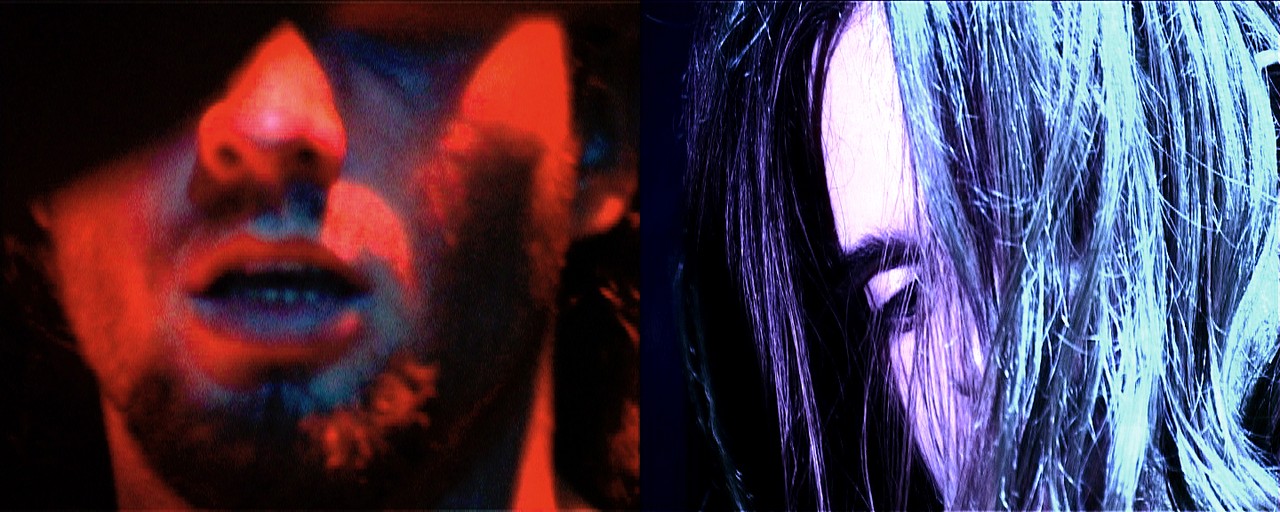
TO THE CROWNED AND CONQUERING CHILD
2007
Videoinstallation
Video transferred to DVD, Sound, 6’33’’, Loop
Diving into a sonically and visually highly coded scene of Metal culture this video elaborates on the cultic mise-en-scène between audience and performer, on the cracks in the construction of aggressive brutality where it shifts to a sensually loaded bodily experience.
2007
Videoinstallation
Video transferred to DVD, Sound, 6’33’’, Loop
Diving into a sonically and visually highly coded scene of Metal culture this video elaborates on the cultic mise-en-scène between audience and performer, on the cracks in the construction of aggressive brutality where it shifts to a sensually loaded bodily experience.

Girls with Guns
2004
4 channel video installation, size variable, Loop
The projections are to be installed as a 4 sided space, having the images facing to the center of the room, thus to the audience.
Referring to a visual language of film noir, exploitation movies, female empowerment, diverse Hollywood heroins and pop cultural imagery of women with guns this works examines the thin line between contemplating over the female body, thus objectifying it and disrupting common habits of seeing and thereby throwing the gaze back from screen to the one who’s “just” looking.
2004
4 channel video installation, size variable, Loop
The projections are to be installed as a 4 sided space, having the images facing to the center of the room, thus to the audience.
Referring to a visual language of film noir, exploitation movies, female empowerment, diverse Hollywood heroins and pop cultural imagery of women with guns this works examines the thin line between contemplating over the female body, thus objectifying it and disrupting common habits of seeing and thereby throwing the gaze back from screen to the one who’s “just” looking.
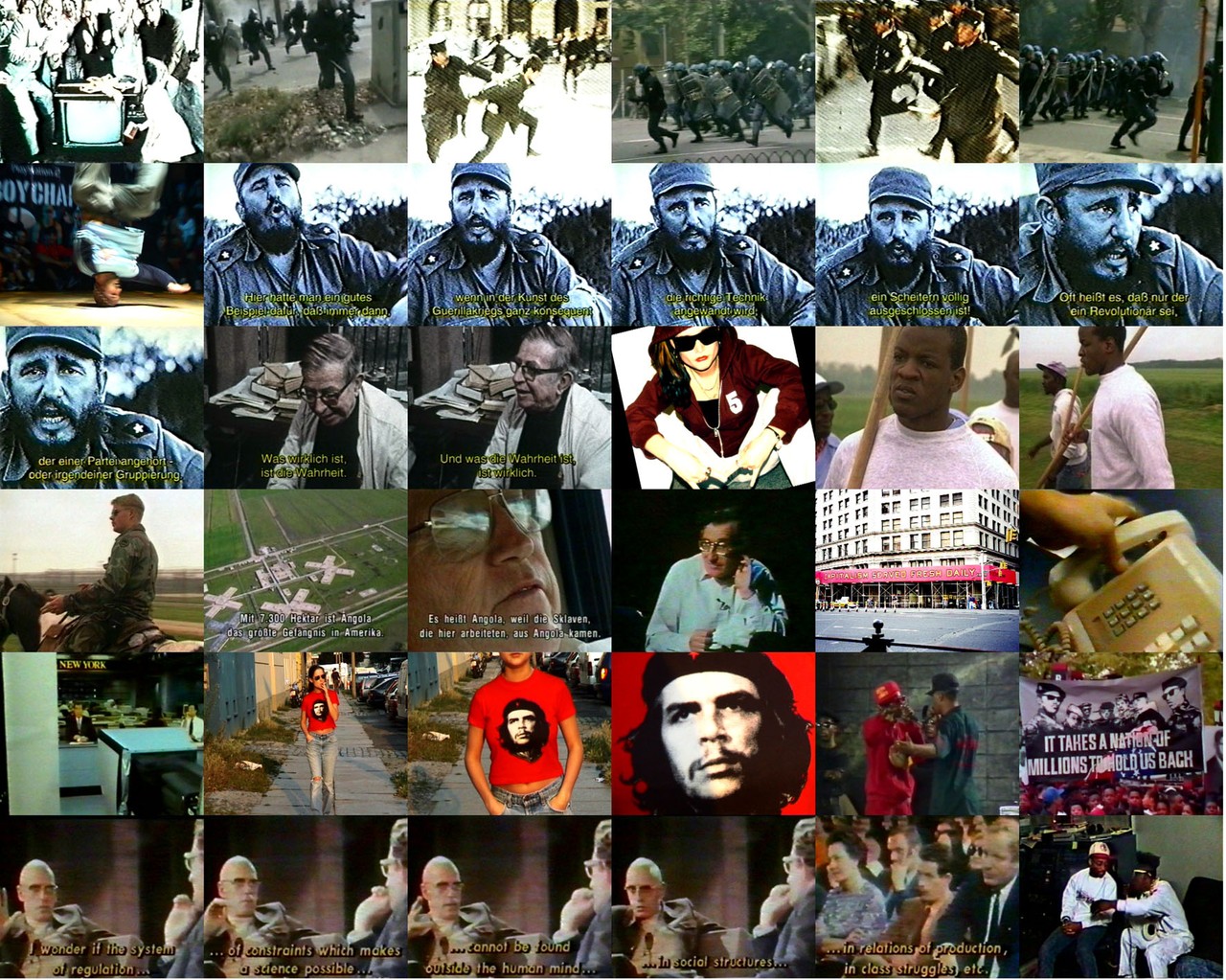
I like revolutions
2002
Video transferred to DVD, Sound, 3’45’’
„You can think of sampling as a story you are telling yourself - one made of the world as you can hear it, and the theatre of sounds that you invoke with those fragments is all one story made up of many. (...) Today, when we browse and search, we invoke a series of chance operations - we use interfaces, icons, and text as a flexible set of languages and tools. Our semantic web is a remix of all available information - display elements, metadata, services, images, and especially content - made immediately accessible.“ Paul Miller, aka DJ Spooky
I like revolutions is sampling various visual and sound material that is referring to different notions of revolution: The stage is opened to such diverse positions like Fidel Castro, Jean Paul Sartre, the demonstrators of May ‘68 in Paris or the ones in Genoa in 2001, Noam Chomsky, NWA, Che Guevara, Public Enemy, Michel Foucault, the inmates in America’s largest prison named Angola, Flava Flav and finally Lee Scratch Perry.
2002
Video transferred to DVD, Sound, 3’45’’
„You can think of sampling as a story you are telling yourself - one made of the world as you can hear it, and the theatre of sounds that you invoke with those fragments is all one story made up of many. (...) Today, when we browse and search, we invoke a series of chance operations - we use interfaces, icons, and text as a flexible set of languages and tools. Our semantic web is a remix of all available information - display elements, metadata, services, images, and especially content - made immediately accessible.“ Paul Miller, aka DJ Spooky
I like revolutions is sampling various visual and sound material that is referring to different notions of revolution: The stage is opened to such diverse positions like Fidel Castro, Jean Paul Sartre, the demonstrators of May ‘68 in Paris or the ones in Genoa in 2001, Noam Chomsky, NWA, Che Guevara, Public Enemy, Michel Foucault, the inmates in America’s largest prison named Angola, Flava Flav and finally Lee Scratch Perry.
To watch the videos online, please request the link and password under: studio[at]polasieverding.com
